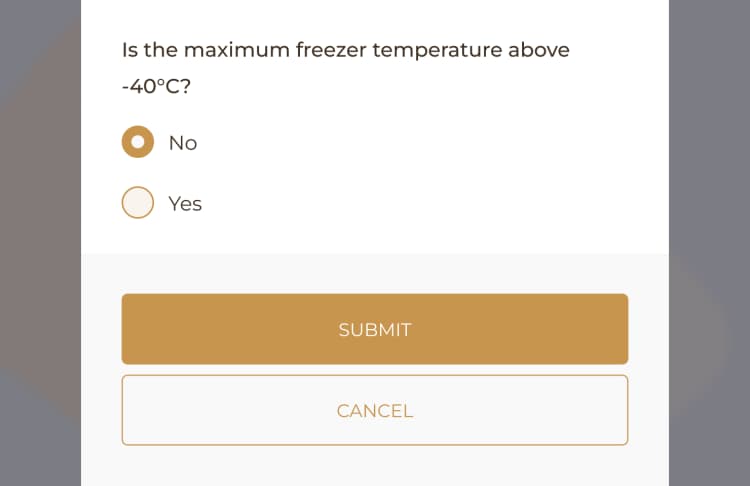Emergency Light Battery Testing Log


How it works


Frequently asked questions
To complete monthly emergency light battery testing, use the QR code or menu option to access the log template in the PreferredMD system. Locate the emergency light panel and inspect the battery. Document the results by entering the relevant information into the designated log within the PreferredMD compliance system.
To edit the monthly Emergency Light Battery Test log on a smartphone, first locate the log by scanning the provided QR code using the camera application or accessing it from the facility documents menu. Select the "edit entry" option and select the desired room to edit the entry details. If editing privileges are not enabled, please contact your facility administrator to request updating of permissions.
To update the monthly Emergency Light Battery Test log on an Android device, scan the provided QR code using the default Camera application or locate the log within the Facility Documents module of the PreferredMD system. Once opened, select the "Edit Entry" option located in the top-right corner of the screen and navigate to the room requiring a battery status update. Should you encounter issues editing the log, please contact your facility administrator to request the necessary privileges be enabled for your user profile.
Accredited ambulatory surgical facilities (ASCs) and office-based surgery centers (OBCs) must complete monthly emergency light battery testing to maintain compliance with requirements established by the Accreditation Association for Ambulatory Health Care (AAAHC) or the Ambulatory Accreditation Program (AAA).
Industries that needs emergency lights battery in facilities or industries like ambulatory surgery centers, laboratories, office based surgery centers, manufacturing plants, and storage facilities handling sensitive materials need to complete Emergency Light Battery Test - Monthly log.
The Emergency Light Battery Test - Monthly Log is conducted by the designated staff member responsible for monitoring and maintaining environmental conditions within a facility. The individual tasked with completing this log varies depending on the organization but typically includes facilities managers, maintenance technicians, quality control specialists, or other trained personnel.
It is imperative that the staff member recording the Emergency Light Battery Test - Monthly Log is reliable and adheres strictly to the scheduled intervals for accurately documenting the status of emergency lighting systems.
Emergency lighting ensures safe evacuation during hazardous situations like power outages or when sunlight and main power are unavailable. Checks should include key areas such as general rooms, operating rooms, procedure rooms, pre-operation rooms, recovery rooms, post-anesthesia care units, clean storage, stairs, and generators. These logs note observations. Maintaining accurate emergency lighting logs is crucial for quality control, regulatory compliance, and troubleshooting issues with battery tests. Routine inspections through logging can timely identify maintenance needs or replacement requirements.
The Emergency Light Battery Test report for monthly testing should include the date and time of the test, the specific location tested, the results of the test, any deficiencies found, details of corrective actions taken or planned, information about the personnel conducting the test, and any additional comments or recommendations.
Penalties for the late completion of an Emergency Light Battery Test, conducted monthly, can vary depending on the jurisdiction and the specific regulations in place. In some cases, fines may be imposed for non-compliance with safety standards, particularly if it poses a risk to occupants in the event of an emergency.
The emergency light battery test must be completed on a monthly basis, with the deadline by the end of each month. It is recommended to conduct the test in the morning and/or during daylight hours to ensure the batteries are tested at an appropriate ambient temperature.
The purpose of conducting the monthly emergency light battery test is to monitor rooms that are considered critical, such as those where invasive medical procedures are performed or where sterile medical supplies are stored, and ensure they remain in constant regulatory compliance when in use for their intended medical purposes. The monthly emergency light battery test log helps ensure each critical room is consistently maintained at the appropriate operational standards at all times.
The purpose of conducting the monthly emergency light battery test is to monitor rooms that are considered critical, such as those where invasive medical procedures are performed or where sterile medical supplies are stored, and ensure they remain in constant regulatory compliance when in use for their intended medical purposes. The monthly emergency light battery test log helps ensure each critical room is consistently maintained at the appropriate operational standards at all times.
Emergency light battery data loggers help facilities managers monitor illumination levels within buildings. The systems detect light level changes, recording data continuously. Personnel receive automated alerts if conditions become unsafe or do not meet standards. Organizations can leverage insights into maintenance needs, compliance, and improving workplace environments long-term.
This monthly log tracks the testing of emergency light batteries across key areas. For each area listed, indicate the status of the emergency light battery and include any relevant notes. Keeping this log up to date will help ensure life safety equipment remains operational and allow any issues to be promptly addressed.
Monthly functional tests must last at least 30 seconds, with a 3- to 5-week interval. The code allows for extensions with proper justification. An annual test of 90 minutes is also required, with the emergency lighting equipment fully operational throughout.
Emergency lighting can be provided by storage batteries, unit equipment, or an on-site generator. This guide covers unit equipment (also known as battery-operated emergency lights) and EXIT signs with a battery-operated emergency illumination source.
Emergency Light Battery Testing Log can be completed electronically via QR code scan or manually. Scanning the provided QR code with a mobile device will direct you to an online form. Alternatively, log in through the PreferredMD portal on any desktop. Ensure monthly light tests are conducted as required and results fully documented for safety and compliance. Contact for additional questions.
A monthly emergency light battery test log can be edited on an Android device by scanning the associated QR code. Users should scan the QR code with their device camera and select "Edit Entry" displayed top-right. This allows authorized staff to directly update the log from their mobile as needed. Maintaining an accurate log is important for safety compliance.
Emergency and exit lighting systems play a critical life-safety role in buildings by illuminating egress paths for occupants should a fire occur. Given their importance in facilitating safe evacuation during emergencies, it is imperative that these systems are properly maintained and undergo routine functional testing.
As per regulatory requirements, the attached emergency light battery testing log must be completed on a monthly basis. Testing should occur early in the day while clinical areas are operational.
The results of monthly emergency light battery tests may vary somewhat throughout the period depending on building usage and occupancy levels. Battery charge levels would generally be expected to gradually decrease over the course of a month as emergency lighting units remain powered on and in standby mode within occupied work and common areas.
PreferredMD makes compliance logging simple and paperless





![[object Object]](/_next/image?url=https%3A%2F%2Fpreferredmd.io%2Fimages%2Flog-template%2Flogs-dashboard.webp&w=750&q=75)
Get the
Open log templateRequest a demo and start your paperless journey
Schedule a demo
